Send Email info@xinhuatextile.com
Need Any Help?+86 -13805995216
Send Email info@xinhuatextile.com
Need Any Help?+86 -13805995216
01
Non-woven Fabric's Environmentally Friendly Properties and Manufacturing Process
Non-woven fabric, an environmentally friendly material, is gradually becoming part of our daily lives. With its unique properties and diverse applications, it plays an increasingly important role in various fields. Let's unveil the mysteries of non-woven fabric and explore its charm.
△ Environmentally Friendly Properties
Non-woven fabric, a leading environmentally friendly material, is leading the trend of green living. We are committed to exploring the possibilities of non-woven fabrics, using our innovative spirit and professional expertise to create first-class products and build a first-class company. Let us contribute to the cause of green environmental protection and lead the industry forward. In this wave of green living, non-woven fabrics stand out among green materials with their unique environmentally friendly properties, becoming a leader in green materials. We continue to explore more applications for non-woven fabrics, using our innovative spirit and professional expertise to create high-quality, high-performance products, contributing to the development of green environmental protection.

△ Manufacturing Process
Non-woven fabrics, also known as nonwovens or non-woven fabrics, have attracted attention for their unique manufacturing process and environmentally friendly properties. Instead of spinning or weaving, they are simply formed by aligning or randomly arranging textile staple fibers or filaments, then bonding them mechanically, thermally, or chemically to create a web structure. This material is not only moisture-resistant, breathable, and flexible, but also lightweight, non-combustible, and easily decomposable. It is also non-toxic, non-irritating, and available in a variety of colors, inexpensive, and recyclable, making it a truly environmentally friendly material. Non-woven fabrics are manufactured through processes such as melt spinning, weaving, and hot-pressing, resulting in superior performance compared to traditional fabrics at an affordable price.
△ Material Recycling and Ecological Contribution
Non-woven fabrics are made from polypropylene (PP) pellets through a series of continuous processes, including high-temperature melting, spinning, weaving, and hot-pressing. Despite being called "fabric," non-woven fabrics are not woven. Instead, they are made by mixing chemical and plant fibers in a water or air suspension medium on a wet or dry papermaking machine. This material not only resembles cloth in appearance but also exhibits numerous performance advantages, such as excellent strength, breathability, waterproofing, environmental friendliness, non-toxicity, flexibility, and durability. It is also affordable and recyclable, making it a truly green and environmentally friendly material. Unlike traditional fabrics, nonwoven fabrics are recyclable and have a short decomposition lifespan, contributing to ecological protection.
02
Applications and Future Trends of Nonwoven Fabrics
△ Diversified Applications
As an environmentally friendly and efficient textile product, nonwoven fabrics have a wide range of applications. In the medical and sanitary fields, nonwoven fabrics are widely used in medical supplies such as surgical gowns, protective clothing, sterilization wraps, and masks, as well as in daily hygiene products such as diapers, household rags, and wipes. Furthermore, they are often used in home decoration, such as wall coverings, bed sheets, and tablecloths, adding beauty and comfort to the home environment. Nonwoven fabrics also play an important role in the clothing industry, such as linings, fusible interlinings, and wadding, providing essential support and comfort for clothing. In the industrial field, nonwoven fabrics are used as filter materials and insulation materials, providing essential support for industrial production. In addition, agricultural nonwovens, such as crop protection fabrics and seedling cloths, also play a significant role in protecting crops and increasing yields. Furthermore, nonwovens have many other applications, such as space cotton and thermal insulation and sound insulation materials, bringing convenience and comfort to various fields.

△ Industry and Market Trends
With the continuous advancement of technology, nonwoven fabric weaving processes have also achieved significant development. Traditional weaving methods have been gradually replaced by more efficient and environmentally friendly processes. Today, nonwoven production processes are becoming more intelligent and automated, not only improving production efficiency but also reducing energy consumption and environmental pollution. At the same time, the research and development and application of new materials have further promoted innovation and progress in the nonwoven fabric industry, expanding its application in a variety of fields.

△ Future Development Prospects
Non-woven fabrics, a new type of covering material, are often distinguished by their weight per square meter, such as 20g non-woven fabric and 30g non-woven fabric. Their light transmittance gradually decreases with increasing thickness. For example, the light transmittance of 16g/m2 white non-woven fabric is as high as 85.6%, while that of 30g/m2 drops to approximately 60%. In the agricultural sector, the breathability of agricultural non-woven fabrics decreases with increasing thickness, but is also affected by external wind speed and temperature differences. Breathability increases with increasing wind speed and temperature differences. Furthermore, the thermal insulation effect of non-woven fabrics is not only affected by their thickness and mesh size, but also closely related to external factors such as weather and covering method. In winter, when the outside temperature drops, the thermal insulation effect of non-woven fabrics is more pronounced, especially when used as coverings in greenhouses.

By 1998, global nonwoven fabric consumption had climbed to 2.4 million tons, a rapid increase from 400,000 tons in 1970. By 2007, consumption is projected to reach a staggering 4 million tons. In terms of production, the United States leads the world with a 41% share, Western Europe accounts for 30%, while Japan and China account for 8% and 3.5%, respectively. Although China ranks behind in production, its consumption accounts for a staggering 17.5% of global consumption. Currently, man-made fibers still dominate nonwoven production, with polypropylene fiber accounting for 63% of global nonwoven production, and this dominance is not expected to change significantly before 2007. Polyester, viscose, acrylic, and polyamide fibers also contribute to a significant share. Nonwoven fabrics are increasingly used in sanitary absorbents, pharmaceuticals, transportation, footwear, and other fields, and market demand continues to grow.
Please Read On, Stay Posted, Subscribe, And We Welcome You To Tell Us What You Think.
Copyright @ 2025 Xinhua Textile Co., Limited All Rights Reserved. Network Supported
Network Supported
Hi! Click one of our members below to chat on